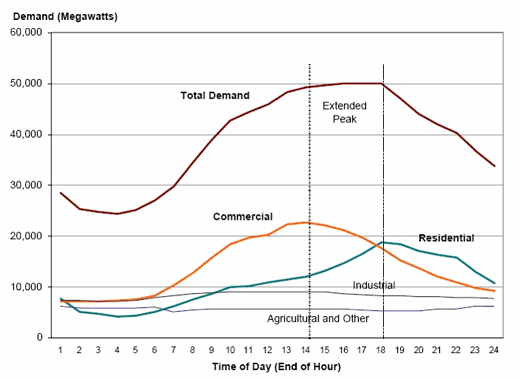System upgrade - The world of tomorrow [Energy load balancing]

Energy load balancing is the process of matching the the electrical supply with the electrical demand, as today, the supply and the demand are sufficient to run our world but the balance is not equilibrated. This is the reason why the price of electricity is changing during the day. At midday, there is a peak of demand causing the price to be very high, the night the supply surpass the demand causing price to drop and electricity to be wasted.

There is three way to adjust the demand and the supply causing an equilibrated match.
- Adjusting the supply.
- Adjusting the price.
- Adjusting the demand.
Adjusting the price is an automated way to refine both side but not an end in itself.
Adjusting the supply is very difficult, most electrical source can not decide when to produce electricity, only hydroelectric power plant can be used as a balancing tool. That is, the supply can be adjusted but not as much as it is needed.

Adjusting the demand is also very difficult, most electrical consumers can't decide when to consume electricity, only a few applications, often in the industry field can adjust their consumptions in very rare and specifics case. That is, the demand can be adjusted but not as much as it is needed.
The only solution we have so far today is grid energy storage (also called large-scale energy storage) that is a collection of methods used to store electrical energy on a large scale within an electrical power grid. Electrical energy is stored during times when production exceeds consumption, and returned to the grid when production falls below consumption.
Grid energy storage
As of 2016, by far the largest and most efficient form of grid energy storage on grids is dammed hydroelectricity, with both conventional hydroelectric generation as well as pumped storage.
As hydroelectric power plant highly depend on the environment within the geographical grid, there are not scalable to a full grid load balancing.
Other solutions within grid energy storage except pumped-storage hydroelectricity cited above are air, batteries and fuel cell. Considering production cost and low cycle durability, batteries are not a substainable means. Compressed air system and hydrogen fuel cell system are the only grid energy storage solutions avaible.
Compressed air storage
Compressed air storage is typically around 60–90% efficient. Such systems can only be designed for this purpose, considering high production cost, this system is however enough efficient to be used but not enough efficient and cost-efficient to fully regulate the electrical load balancing.
This system is however a quite great solution to regulate the electrical load balancing during high production peak.
Hydrogen fuel cell
The AC-to-AC efficiency of hydrogen storage has been shown to be on the order of 20 to 45%, which imposes economic constraints. As the technology is still very young, recent research demonstrated that the efficiency is able to reach the compressed air storage efficiency.
As the technology is being used in the transportation field as a replacement of batteries, and the in power backup for building field, theses systems could be used as a substainable electrical load balancing, producing hydrogen when the supply is at it's peak and producing electricity when the demand is at it's peak enabling an investment-free grid energy storage solutions.
Grid balancing
A grid balancing system monitor supply and demand, adjust price feed and coordinate flexible supply and grid energy storage systems.
As the grid balancing system is something critical in a society to run, the system must have 100% up-time, be secure and be efficient, thus mean that the time unit should be relatively short (~15 sec) to ensure a real-time price feed and a descentralized or distributed ledger to ensure the system to not have a single point of failure sensitive on natural and artificial attack.
If the ledger is based upon a single point of failure, the whole electrical network can be shuted down on a simple, single failure, making the whole sector or country in a deep shit.
A dristributed ledger can be used as a grid balancing system to monitor supply and demand, set price feed, coordinate flexible supply and grid energy storage systems and process credit/debit transactions, enabling a autonomous, 100% up-time, real-time, cheap, and without possiblities of compromising data system. A such system would save cost, be much more reliable, have a better up-time, and permit anyone to join the grid without risks or fraud.
One of the best way would be to use a dristributed ledger based upon the blockchain technology such as graphene or tendermint. As a large amount of data need to be stored in a secure, immutable way, a combination with IPFS to store archived data is needed, storing the IPFS file address and the IPFS file footprint. IPFS would provide a better scalability to the blockchain.
The better way to deal with city, districts, and country regulation would be to use a fractal pattern of grid balancing dirstributed ledger, in other terms multiples nested dirstributed ledger.